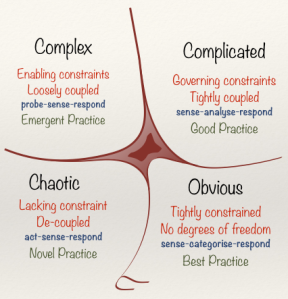When people say ‘Simplifying Complexity’ I hear ‘I don’t know what these words mean’. This isn’t entirely fair, as we shall see, but it gives you an idea of my preconceptions before attending a training session of that title.
The facilitator started off by inviting each member of the group to talk about the influence of complexity in their professional lives. As we went around the room it became clear that for most of the group complexity was a synonym for hard or complicated. Many would agree, including the Oxford English dictionary. However, here was a group dominated by senior members of a very large IT professional services company. These are people for whom complexity science is highly relevant to their professional lives and people for whom there ought to be value in defining Complexity with a big C and in particular differentiating the Complex from the Complicated.
Cynefin
The Cynefin Framework characterises systems (and problem spaces) into five classes – Simple, Complicated, Complex, Chaotic and Disordered. Once the class of a system is identified the framework provides guidance on how to work most effectively with the system. On a personal level I find it very useful in explaining to me not only why an incremental and iterative approach generally works well in software development, it also suggests to me under what circumstances such as approach does not hold. You won’t see NASA using Scrum for instance, more on that later.
Cynefin can be expressed visually like so:-

Credit Wikipedia
The key distinction I see is that of Complex and the Complicated.
- Complicated
An example of a complicated task is building a submarine. It’s definitely not trivial, but if the tasks are broken down sufficiently the problem is tractable and predictable – essentially it becomes a series of Simple tasks. By contrast a Complex task retains its complexity even after being broken down.
- Complex
An example of a Complex task could be to ask a room of people to arrange themselves such that the closest person to them is exactly half the distance from them as that of the 2nd closest. It would be extremely difficult for an individual to orchestrate this task, instead each individual actor must make a small change, observe the consequence and then make a further change based on the feedback.
What does this mean for Software?
Taking a manufacturing production line as an example, once it reaches steady state the system can be described as Complicated and is predictable. This is important because for many years Software Development looked to the world of manufacturing for guidance. In doing so, implicitly defining software development as a Complicated task. The thinking being that with sufficient up front analysis the problem could be solved without a line of code being being written. It is for this reason that the Waterfall model rose to such prominence and was so readily adopted.
More recently manufacturing has been shown to be an inadequate metaphor and that in fact software development is more akin to product design, thereby inhabiting the Complex quadrant. This means that the correct approach, according to Cynefin, is to probe, sense and respond. In effect the iterative and incremental approach practiced by those inspired by Agile and Lean thinking.
So what does this mean for NASA?
If what I say is correct, what does this mean for NASA? After all they have some of the smartest brains on the planet available to think about this sort of thing and yet their processes appear to assume a Complicated rather than a Complex environment.
NASA is an extreme organisation and it is only natural that what works for them will deviate from the common case. Despite the challenging nature of their work I would argue that their domain is Complicated rather than Complex.
Complex systems are characterised by there being many unknowns and an inability to determine the nature of those unknowns at the beginning of the process. In NASA’s case they are genuinely in a position where, for software at least, the problem space is well defined.
For instance, the software runs upon hardware based on Intel’s 386 architecture, hardly cutting edge, but whose behaviour (warts and all) is well understood and has not changed in years. This means that the inputs to the system are well understood and the behaviour deterministic. NASA has managed to turn what would ordinarily be a Complex system (that of software development) into a Complicated system and in doing so their software teams work to vanishingly small defect rates, albeit at enormous cost and at the expense of delivery time. I found this article to be a fascinating insight into their working practices.
In conclusion, Complexity science provides a means to characterise systems, the Cynefin framework provides definitions to differentiate the Complex from the Complicated. Software development is almost always Complex though it was originally assumed to be Complicated. This is why agile and lean approaches have been shown to much more effective than traditional methods that assume a Complicated system such as Waterfall.